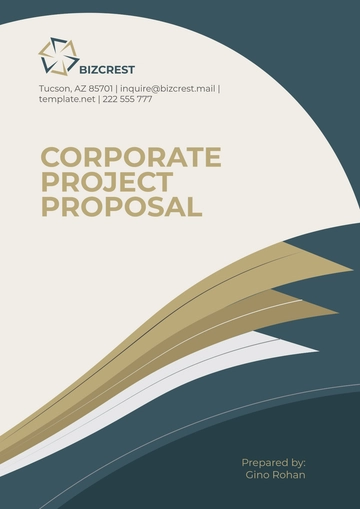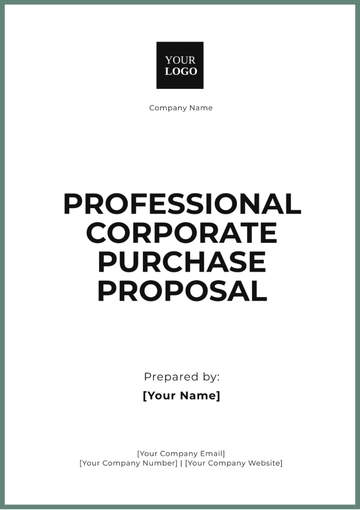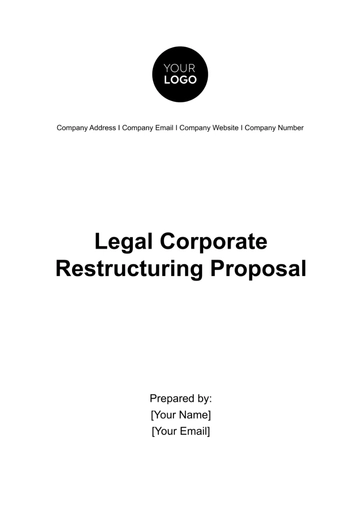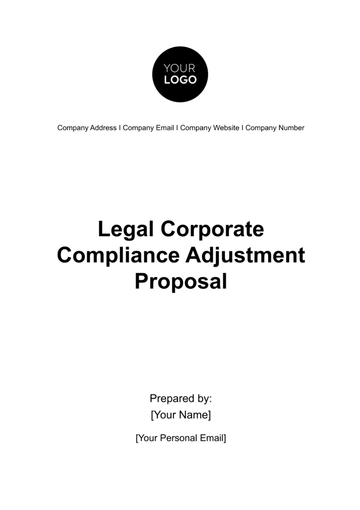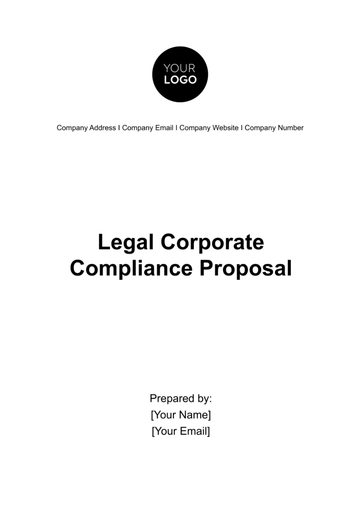Free Legal Corporate Compliance Proposal
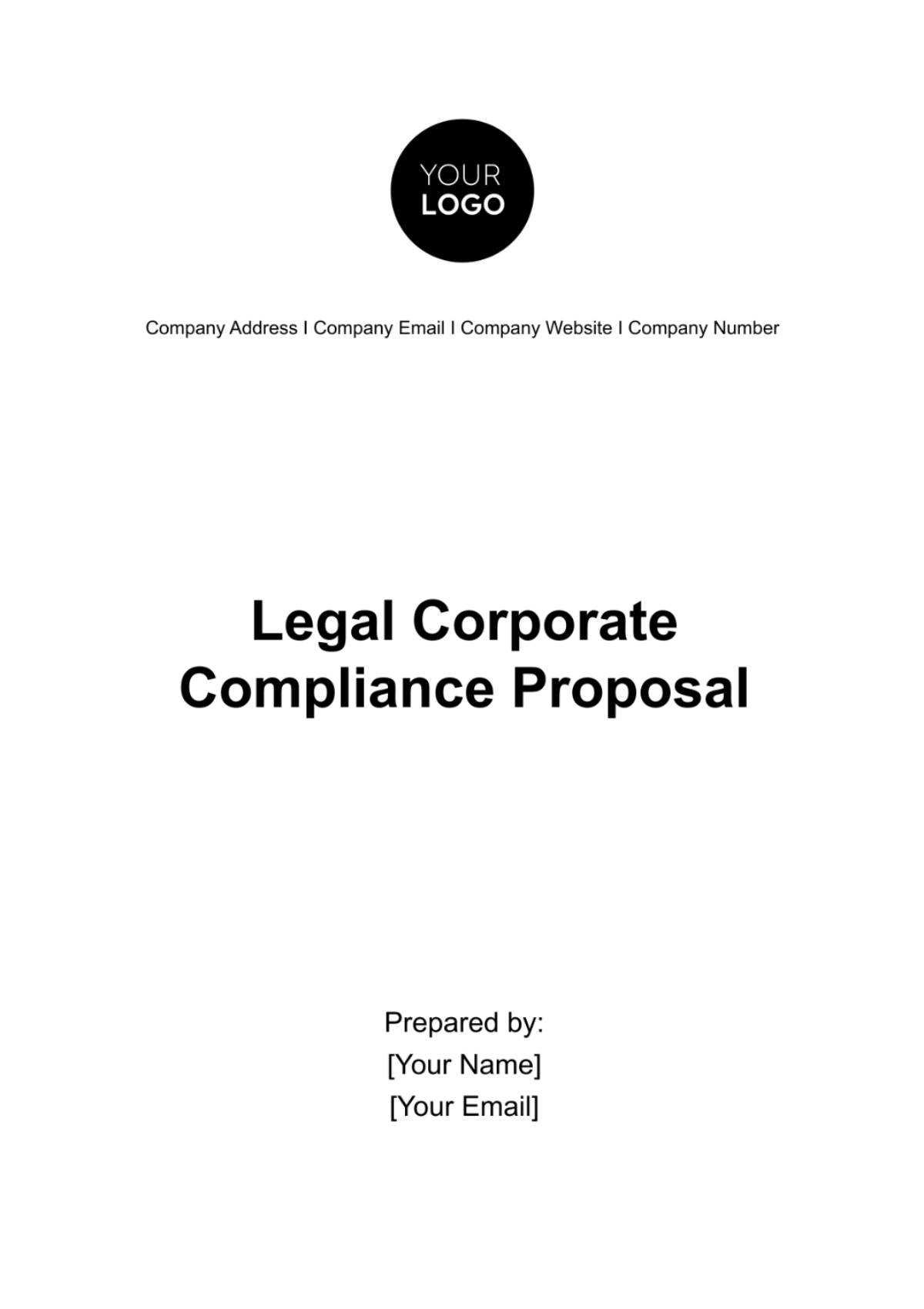
I. Introduction
In today's rapidly evolving regulatory landscape, it is imperative for us to establish and maintain a robust corporate compliance program. Recognizing the complexity of legal requirements and the risks associated with non-compliance, we are committed to upholding the highest standards of integrity and ethical conduct in all our business operations. This proposal outlines our approach to developing a comprehensive compliance framework that not only meets but exceeds regulatory expectations. By identifying our current compliance status and gaps, we aim to create a culture of compliance that permeates every level of our organization, ensuring that our business practices are in full alignment with legal and regulatory requirements.
II. Compliance Objectives
Our primary goal is to implement a corporate compliance program that effectively mitigates risks, promotes ethical behavior, and ensures ongoing adherence to applicable laws and regulations. To achieve this, we have set forth the following specific objectives:
Establish clear compliance policies and procedures that are easily accessible and understandable to all employees.
Conduct a thorough risk assessment to identify potential compliance vulnerabilities and develop strategies to address them.
Provide comprehensive training and education to employees on relevant compliance issues, laws, and regulations.
Implement robust monitoring and auditing systems to detect compliance deviations and enforce compliance standards.
Create an open and transparent environment where employees feel empowered to report compliance concerns without fear of retaliation.
Ensure that our compliance program is dynamic and adaptable to changes in the regulatory environment and our business operations.
III. Regulatory Environment
Navigating the regulatory environment is a critical component of our compliance program. We operate in a context governed by numerous laws and regulations designed to ensure fair practices, protect consumers, and maintain the integrity of the marketplace. It is crucial for us to stay informed and compliant with all relevant regulations. Key U.S. laws that apply to our operations include, but are not limited to:
Sarbanes-Oxley Act (SOX): Establishes stringent standards for all U.S. public company boards, management, and public accounting firms.
Dodd-Frank Wall Street Reform and Consumer Protection Act: Implements comprehensive financial regulatory reform measures.
Foreign Corrupt Practices Act (FCPA): Prohibits bribery of foreign officials and requires the maintenance of accurate books and records.
Health Insurance Portability and Accountability Act (HIPAA): Protects sensitive patient health information from being disclosed without consent or knowledge.
Federal Sentencing Guidelines for Organizations (FSGO): Provides a framework for sentencing organizations convicted of federal criminal offenses, including compliance and ethics program requirements.
General Data Protection Regulation (GDPR): Affects companies that process the personal data of individuals in the EU, emphasizing privacy and data protection.
IV. Risk Assessment
A thorough risk assessment is the cornerstone of an effective compliance program. By identifying potential areas of compliance risk, we can tailor our strategies to mitigate these risks effectively. Our risk assessment process evaluates the nature of each risk, its potential impact on our organization, and the likelihood of its occurrence. This comprehensive approach ensures that we prioritize our resources and efforts to address the most significant risks. Below is a summary of our key identified risks, their potential impacts, and their likelihood:
Overview of Risk | Impact | Likelihood |
Non-compliance with financial regulations | High | Moderate |
Violations of anti-bribery and corruption laws (e.g., FCPA) | High | Low |
Breaches of data privacy and security (e.g., GDPR, HIPAA) | High | High |
Failure to adhere to employment laws | Moderate | Moderate |
Non-compliance with environmental regulations | Moderate | Low |
Our prioritization of these risks is based on a combination of their potential impact and likelihood. Breaches of data privacy and security are deemed the highest priority due to their high impact and high likelihood, necessitating robust safeguards and continuous monitoring. Non-compliance with financial regulations also ranks high due to the significant legal and financial ramifications, despite a moderate likelihood. Violations of anti-bribery and corruption laws, while less likely, carry severe consequences that could damage our reputation and financial standing, making it a critical focus area. Employment law compliance and environmental regulations, given their moderate impact and likelihood, require diligent management to ensure ongoing compliance and mitigate potential risks.
V. Compliance Strategies
To address the identified risks and achieve our compliance objectives, we have developed a series of strategic initiatives:
Development of Comprehensive Policies and Procedures: We will create clear, accessible compliance policies and procedures to guide employee conduct and ensure adherence to legal and regulatory standards. Each policy will be tailored to address specific risks, providing employees with the knowledge and tools needed to navigate complex compliance landscapes effectively.
Comprehensive Training and Education Programs: A key strategy involves rolling out extensive training programs designed to educate our employees about compliance requirements relevant to their roles. These programs will include both initial and ongoing training sessions to ensure that all team members are aware of their compliance obligations and how to fulfill them.
Robust Monitoring and Auditing Systems: Implementing state-of-the-art monitoring and auditing systems will allow us to detect compliance deviations early and take corrective action. These systems will include regular compliance audits, real-time monitoring of key compliance indicators, and mechanisms for employees to report potential compliance issues anonymously.
Responsive Reporting and Communication Channels: Establishing open lines of communication where employees can report compliance concerns without fear of retaliation is crucial. We will develop a confidential reporting system, complemented by a clear process for investigating and addressing reported issues.
Continuous Improvement and Adaptation: Recognizing that the regulatory environment is ever-changing, we commit to regularly reviewing and updating our compliance program. This includes adjusting our strategies in response to new regulatory developments, emerging risks, and feedback from our compliance audits.
VI. Compliance Program Components
The foundation of our compliance initiative is built upon the development and implementation of key components that ensure the effectiveness and sustainability of our program. These components are designed to address the identified risks, enforce compliance with legal and regulatory requirements, and instill a culture of integrity throughout our organization. Through a combination of policies and procedures, training and education, monitoring and auditing, and clear reporting mechanisms, we aim to achieve our compliance objectives and maintain the highest standards of ethical conduct.
A. Policies and Procedures
To establish a robust framework for compliance, we will develop and implement a comprehensive set of policies and procedures. These documents will serve as a guide for our employees, outlining the expectations for behavior and the steps necessary to comply with legal and regulatory standards. Our policies and procedures will cover a wide range of areas, including but not limited to:
Code of Conduct: Defining ethical behavior for all employees.
Anti-Bribery and Corruption: Preventing bribery and corruption in line with the FCPA and other relevant laws.
Data Privacy and Security: Ensuring the protection of personal and sensitive information as required by GDPR, HIPAA, and other data protection laws.
Financial Reporting: Adhering to standards set by SOX, Dodd-Frank, and other financial regulations.
Employment Practices: Complying with labor laws and regulations, ensuring fair treatment and equal opportunities for all employees.
Environmental Compliance: Meeting environmental regulations and promoting sustainable practices.
B. Training and Education
A critical element of our compliance program is the provision of training and education to all employees. Training programs are designed to ensure that employees understand their compliance obligations and how to fulfill them. Below is an overview of our planned training programs, their duration, and frequency:
Program | Duration | Frequency |
Code of Conduct Orientation | 2 hours | Upon hire |
Anti-Bribery and Corruption Training | 3 hours | Annually |
Data Privacy and Security Awareness | 4 hours | Annually |
Financial Compliance Essentials | 3 hours | Bi-annually |
Employment Law Compliance | 2 hours | Annually |
Environmental Regulations Briefing | 1 hour | Annually |
C. Monitoring and Auditing
An integral part of our compliance program is the establishment of robust monitoring and auditing mechanisms to ensure adherence to our policies and procedures and to identify areas for improvement. These mechanisms enable us to detect compliance deviations early, take corrective action, and refine our program to better manage risks. Our approach to monitoring and auditing includes:
Regular Compliance Audits: Conducting scheduled audits to assess adherence to compliance policies and legal requirements, identify gaps, and recommend improvements.
Real-Time Monitoring Systems: Implementing technology solutions for continuous monitoring of key compliance indicators, such as financial transactions, data access logs, and employee compliance training completion rates.
Spot Checks: Performing unscheduled spot checks in high-risk areas to ensure ongoing compliance and deter non-compliant behavior.
Employee Surveys and Feedback: Gathering input from employees on the effectiveness of the compliance program and areas of concern through anonymous surveys and feedback mechanisms.
D. Reporting and Communication
Clear, open channels for reporting and communication are essential to the success of our compliance program. Employees must feel empowered and safe to report potential compliance issues without fear of retaliation. To facilitate effective reporting and communication, we have established the following guidelines:
Confidential Reporting Hotline: Providing a confidential hotline and online portal for employees to report suspected violations of policies, legal requirements, or ethical standards anonymously.
Non-Retaliation Policy: Enforcing a strict non-retaliation policy to protect employees who report compliance concerns in good faith from any form of retaliation or adverse employment action.
Open-Door Policy: Encouraging employees to discuss compliance questions and concerns directly with their supervisors, the compliance department, or human resources.
Regular Updates: Communicating regularly with employees about compliance initiatives, updates to policies and procedures, and the importance of compliance through newsletters, intranet posts, and staff meetings.
Compliance Officer Communications: Ensuring the Compliance Officer is accessible to all employees for guidance on compliance matters, clarification of policies, and support in reporting issues.
VII. Implementation Plan
To ensure the successful rollout of our compliance program, a detailed implementation plan has been developed, outlining the key steps, associated timelines, and responsibilities. This structured approach allows for efficient allocation of resources, timely completion of each phase, and accountability across departments. The plan is designed to be flexible, allowing for adjustments as necessary to address emerging risks or regulatory changes.
Step | Timeline | Responsibility |
Development of Policies and Procedures | Month 1-3 | Compliance Department |
Setup of Training Programs | Month 2-4 | HR & Compliance Department |
Implementation of Monitoring Systems | Month 3-5 | IT & Compliance Department |
Launch of Reporting and Communication Channels | Month 4 | Compliance Department |
Initial Compliance Audit | Month 6 | External Auditor |
Review and Adjustment of Program | Month 7 | Compliance Department |
VIII. Budget and Resources
The allocation of an appropriate budget and resources is critical for the implementation and ongoing management of the compliance program. The following table provides an estimate of the budgetary requirements and resources needed to ensure the program's success. These estimates are based on initial assessments and may be adjusted as the program evolves.
Item | Estimated Cost |
Development of Policies and Procedures | $10,000 |
Training Programs | $15,000 |
Monitoring Systems Setup | $20,000 |
Reporting and Communication Channels | $5,000 |
Initial Compliance Audit | $25,000 |
Miscellaneous & Contingency | $10,000 |
Total | $85,000 |
IX. Evaluation and Continuous Improvement
To measure the effectiveness of our compliance program and identify areas for improvement, we will track specific Key Performance Indicators (KPIs) and set target values for each.
KPI | Target Value |
Completion Rate of Compliance Training | 95% |
Number of Compliance Incidents Reported | Reduction by 20% |
Resolution Time for Compliance Issues | Within 30 Days |
Employee Satisfaction with Compliance Program | Score of 4.5/5 |
Continuous improvement will be conducted through regular reviews of these KPIs, feedback from employees, results from compliance audits, and monitoring data. Adjustments to the program will be made based on this analysis to address any deficiencies, adapt to new regulatory requirements, and incorporate best practices. An annual review meeting will be held with key stakeholders to discuss the program's effectiveness and plan for the next cycle.
X. Conclusion
In conclusion, our proposed compliance program represents a comprehensive approach to ensuring that we meet our legal and ethical obligations. Through careful planning, resource allocation, and ongoing evaluation, we are committed to fostering a culture of compliance that supports our organization's values and objectives. By implementing this program, we not only minimize our risk of non-compliance but also reinforce our dedication to operating with integrity and transparency.
- 100% Customizable, free editor
- Access 1 Million+ Templates, photo’s & graphics
- Download or share as a template
- Click and replace photos, graphics, text, backgrounds
- Resize, crop, AI write & more
- Access advanced editor
Discover the Legal Corporate Compliance Proposal Template from Template.net, a pivotal resource for outlining effective compliance strategies within your organization. This editable and customizable template ensures that your proposal addresses all regulatory and ethical standards relevant to your business. Editable in our AI Editor tool, it enables a straightforward approach to developing proposals that are compliant and demonstrate commitment to corporate integrity.
You may also like
- Business Proposal
- Research Proposal
- Proposal Request
- Project Proposal
- Grant Proposal
- Photography Proposal
- Job Proposal
- Budget Proposal
- Marketing Proposal
- Branding Proposal
- Advertising Proposal
- Sales Proposal
- Startup Proposal
- Event Proposal
- Creative Proposal
- Restaurant Proposal
- Blank Proposal
- One Page Proposal
- Proposal Report
- IT Proposal
- Non Profit Proposal
- Training Proposal
- Construction Proposal
- School Proposal
- Cleaning Proposal
- Contract Proposal
- HR Proposal
- Travel Agency Proposal
- Small Business Proposal
- Investment Proposal
- Bid Proposal
- Retail Business Proposal
- Sponsorship Proposal
- Academic Proposal
- Partnership Proposal
- Work Proposal
- Agency Proposal
- University Proposal
- Accounting Proposal
- Real Estate Proposal
- Hotel Proposal
- Product Proposal
- Advertising Agency Proposal
- Development Proposal
- Loan Proposal
- Website Proposal
- Nursing Home Proposal
- Financial Proposal
- Salon Proposal
- Freelancer Proposal
- Funding Proposal
- Work from Home Proposal
- Company Proposal
- Consulting Proposal
- Educational Proposal
- Construction Bid Proposal
- Interior Design Proposal
- New Product Proposal
- Sports Proposal
- Corporate Proposal
- Food Proposal
- Property Proposal
- Maintenance Proposal
- Purchase Proposal
- Rental Proposal
- Recruitment Proposal
- Social Media Proposal
- Travel Proposal
- Trip Proposal
- Software Proposal
- Conference Proposal
- Graphic Design Proposal
- Law Firm Proposal
- Medical Proposal
- Music Proposal
- Pricing Proposal
- SEO Proposal
- Strategy Proposal
- Technical Proposal
- Coaching Proposal
- Ecommerce Proposal
- Fundraising Proposal
- Landscaping Proposal
- Charity Proposal
- Contractor Proposal
- Exhibition Proposal
- Art Proposal
- Mobile Proposal
- Equipment Proposal
- Student Proposal
- Engineering Proposal
- Business Proposal
